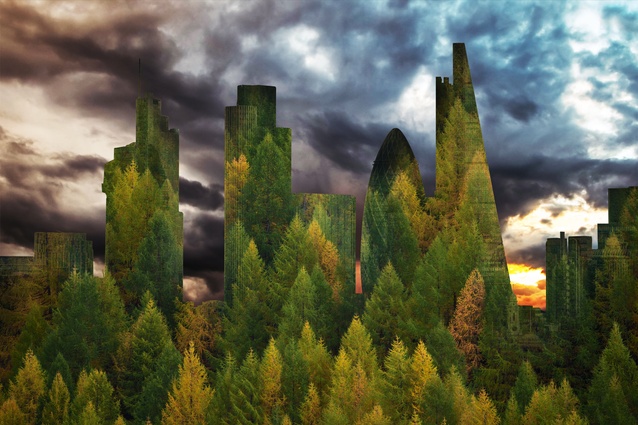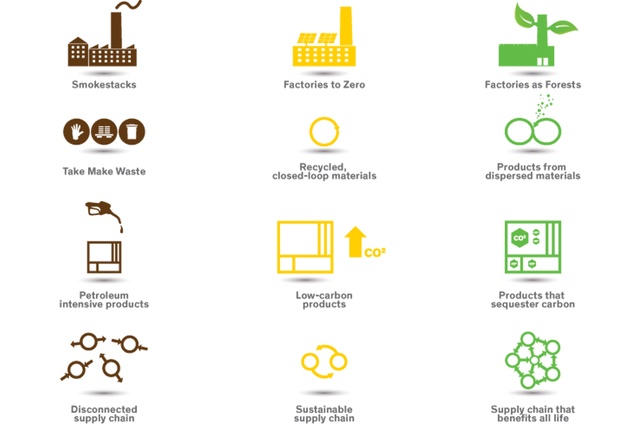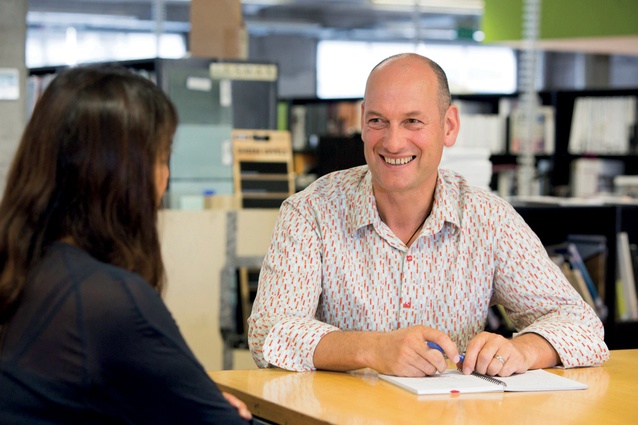Letting nature cool
Partner content: Designing buildings that behave as if they were part of nature is a way of thinking that might just help our goal of cooling the planet.
This planet we live on has ways of regulating its climate. A major one is through weathering, which removes carbon from the ground surface and washes it to the ocean, where it is locked away in natural deposits of limestone. Another way is through vegetation, which absorbs carbon from the atmosphere; this works to a shorter-term extent as, once the vegetation dies and rots, it will again release most of its carbon.
However nature does the job, the extent to which humans populate the surface of the Earth and transform it according to their wills and needs affects how well these systems work. The planet’s systems move slowly and cannot cope with the amount of carbon we create and release into the atmosphere, and so the climate will continue to change more rapidly than is natural.
Allowing nature to do its work is a key way in which to scale back climate change, but to do so requires a universal change, in the way humans think about the Earth. If we are to allow nature to cool, we must see ourselves for what we are – a part of the natural world– rather than distinguising ourselves from the process of nature.
A key way in which we are currently standing in the way of nature’s cooling processes is through our business practices. The majority of businesses prioritise profit over the health of the living system, and this means that the money that is made from the products pumped out of a smokestack factory is more important than is the impact that factory has on its site. Seeing the factory, or home or school or office block, as a part of nature, because it is a part of humanity, is the step that needs to be taken in order to allow the Earth to regulate its temperature with us living on it.
The Living Building Challenge, for example, spells out the ways in which this can be done for a home. Some key ways to allow nature to do its job are: planting green roofs, which insulate, cool and absorb carbon; using solar panel systems, which allow a building to be self-sufficient, without the need for external power sources; and using passive methods of heating and cooling, such as thermal mass, using passive ventilation and good thermal breaks to avoid heat loss and moisture retention.
All of these methods have something in common: they are as good for humans as they are for the Earth, as they provide cleaner, healthier spaces to occupy, while ensuring our occupation on this planet can continue.
What is the Living Building Challenge?
A flower is used to symbolise the clean, efficient nature of a Living Building Challenge-certified project. Each petal represents a requirement and each requirement has a set of imperatives. For instance, under materials, users can choose non-toxic and sustainable products that have the Declare label. A Living Building will give more to its environment than it takes, contributing to the ecosystem of its site.
The Factory as a Forest
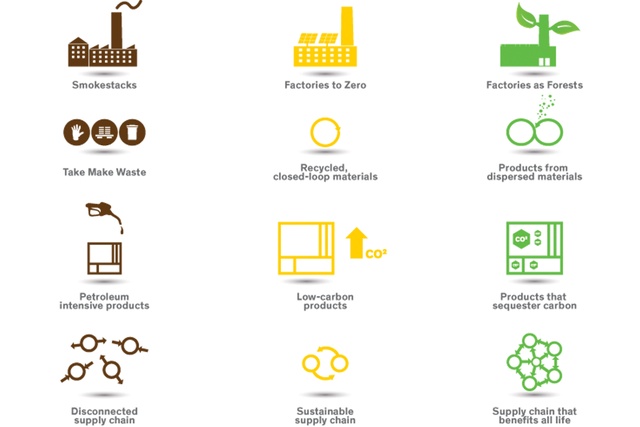
Interface began its sustainability journey in 1994 by asking the question: if nature were to design a company, what would it look like? This has spurred the modular flooring company to move from working out of a smokestack factory, to working from a zero-emissions factory with sustainable production methods and systems, to its final goal of The Factory as a Forest. The ambition is to pass sustainability goals and go even further by creating a factory that actually benefits the site it is a part of. All organisms and processes in nature generate a positive net effect, so the goal is ambitious: how do we create a positive net effect through the creation of products for humans?
Interface has begun by identifying the ecosystems in place in the surrounding living environment close to an existing factory in Sydney, Australia, and quantifying how these natural systems work. These are then to be used as a basis for creating systems in the company’s factories. Each factory will have different systems based on its natural site but each will be based on the pilot study carried out in Australia.
Once the systems in nature are quantified and the goals set, the next step is to implement them in the factory. This is being carried out currently with the expansion of an Interface factory in LaGrange, Georgia. Interface is being advised on the process by Biomimicry 3.8, a firm headed by Janine Benyus, whose statement inspired the idea for The Factory as a Forest: “When the forest and the city are functionally indistinguishable, then we know we’ve reached sustainability.” Biomimicry 3.8 runs workshops and consults with entrepreneurs, business people and scientists about how natural processes can inform the creation of smarter and more environmentally friendly products.
Biomimicry 3.8 is examining the eco-system in LaGrange to quantify levels of sequestered carbon, purified and stored water, sediment, pollination, pollution, biodiversity and soil fertility. It will then take this as a starting point for the systems of the factory working to deliver good. By redesigning the factory using nature, carbon drawdown and water resilience are addressed as priorities.
Through mimicking the extent to which the referenced surrounding ecosystem sequesters atmospheric carbon, together with using only renewable stocks of carbon (such as recycled carpet tiles and other waste resources) instead of non-renewable petrochemicals, the factory can actually reverse climate change.
It is yet to be evident what a factory based on a forest is going to look like but it is likely that there will be plant-based systems in place to purify water and air that leaves the factory, and that it will be a more-productive environment for employees to work within, breathing fresh air and giving back to the place that gives them livelihood. Hopefully, the operational factory will become a model on which to build factories throughout the world, thus changing the face
of industry.
Jerome Partington – Sustainability Manager – Jasmax
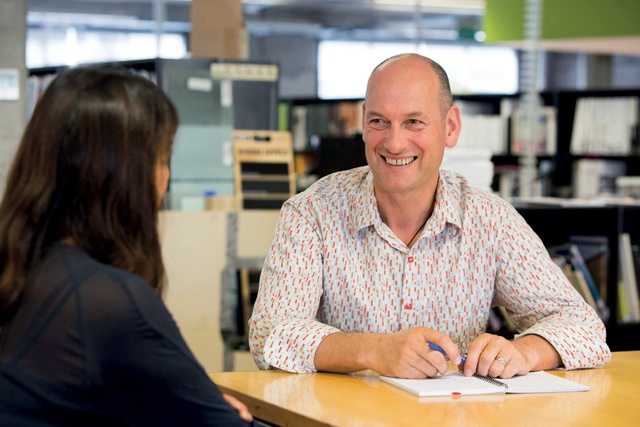
Jerome Partington has a wealth of experience in sustainable and restorative design and eco-building practices, including being the chair of Living Future NZ. At Jasmax, his role involves ensuring the practice follows its environmental management system internally, and working with architects, designers and engineers to use the integrated design process for projects. He was heavily involved in the Tuhoe’s Te Kura Whare, which is currently the only certified living building outside the United States.
What is the integrated design process?
The integrated design process came out of the USA. When they started doing green buildings, it was costing them more, taking longer and not always achieving the right outcomes. That was a result of a linear design process and of people being risk-averse. Integrative design uses the three Es – everyone, everything and early. We start with a discovery phase, maybe a series of workshops, but there is no designing until everyone can understand what we’re trying to achieve. After that, the traditional linear part of the design moves more quickly because you’re super-clear about what you’re doing.
What is the difference between sustainable and regenerative design?
Where you move from green design into regenerative design is in asking how we integrate this project with the natural eco-system, which includes people, nature, place, animals, land and economy. It becomes less about how you design and more about how the project can activate the environment and those who live, work and play in that system to create long-term value. The Living Building Challenge is a gateway into that thinking because you move from siloed thinking to living-systems thinking. The challenge is to change our thinking collectively.
Can you explain living systems thinking?
Traditionally, you look at a problem – climate change or building performance – and reduce is to the smallest scope and find a solution. Living-systems thinking looks at the potential of the system to evolve and be better and healthier. You shifted from problem-solving to working with potential. What happens when you do that is you get much more motivation and desire to engage because you’re not predetermining what the outcome is and you’re not cleaning up someone else’s mess. Dealing with potential is more open-ended and draws people in and gets them excited, and it reflects how the world really works.
ArchitectureNow works with a range of partners in the A&D supply sector to source appropriate content for the site. This article has been supported by Interface and first appeared in Interior magazine.

